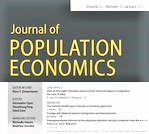An article published in the January 2020 issue of the Journal of Population Economics finds that assortative mating in education has become stronger in the United States, which has contributed to the observed rise in inequality.
Read more in:

The role of evolving marital preferences in growing income inequality
Edoardo Ciscato & Simon Weber
READ LINK: https://rdcu.be/bXokl
Journal of Population Economics 33 (2020), 307–347
Author Abstract: In this paper, we describe mating patterns in the USA from 1964 to 2017 and measure the impact of changes in marital preferences on between-household income inequality. We rely on the recent literature on the econometrics of matching models to estimate complementarity parameters of the household production function. Our structural approach allows us to measure sorting along multiple dimensions and to effectively disentangle changes in marital preferences and in demographics, addressing concerns that affect results from existing literature. We answer the following questions: Has assortativeness increased over time? Along which dimensions? To what extent can the shifts in marital preferences explain inequality trends? We find that, after controlling for other observables, assortative mating in education has become stronger. Moreover, if mating patterns had not changed since 1971, the 2017 Gini coefficient between married households would be 6% lower. We conclude that about 25% of the increase in between-household inequality is due to changes in marital preferences. Increased assortativeness in education positively contributes to the rise in inequality, but only modestly.
Read also the Lead Article of issue 1 (2020):
Hate at first sight? Dynamic aspects of the electoral impact of migration: the case of Ukip
Eugenio Levi, Rama Dasi Mariani & Fabrizio Patriarca
FREE READ LINK: https://rdcu.be/bXnWI
Journal of Population Economics, Vol. 33 (2020), Issue 1 (January), pp. 1-32.
GLO Fellows Eugenio Levi, Rama Dasi Mariani & Fabrizio Patriarca
Complete issue 1, read access to all articles.
Ends;
